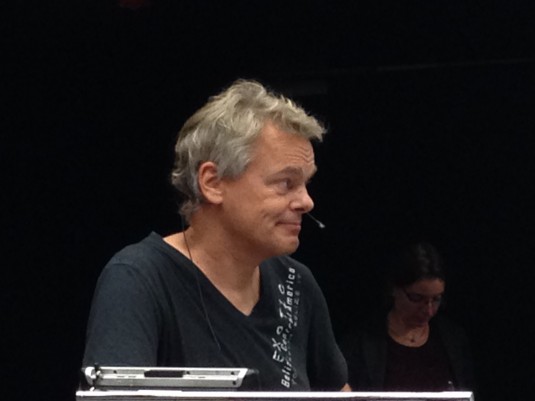„It’s important to think differently from others“
How Edvard Moser found the grid cells
Researchers have penetrated deep into the brain, and have found an orientation system there. Nobel Prize laureate Edvard Moser talks about the discovery of the grid cells.

Edvard Moser looking at an overcrowded lecture hall in October 2014 at the Max Planck Institute in Munich
Edvard and May-Britt Moser discovered cells in the middle of the brain that make orientation possible. On 10th December 2014, they and a colleague received the Nobel Prize for the discovery of this „internal GPS system“.
About how many interviews have you given since the announcement of the Nobel Prize, Dr. Moser?
In the first few days, there was one interview after another, about 15 to 20 a day, sometimes several at a time. That was really crazy. Now, more than two weeks after the announcement, there are still two or three a day. I enjoy the recognition, but if it goes on like this I won’t get anything else done.
You, your wife May-Britt Moser and John O’Keefe are receiving the Nobel Prize for discovering orientation cells in the brain. What is it that’s so special about these cells?
Until recently, researchers focused mainly on functions in the brain that are located not all that far from where sensory signals enter the brain. But we went deeper, right into the middle of the brain, and discovered cells there that represent features of the outside world. These cells create a map that helps animals and people to navigate in space. We had opened a window that helps us to understand some of the processes that take place deeper in the brain.
Why did you look so deep inside the brain?
John O’Keefe had discovered some interesting cells there while doing some experiments with rats in 1971, and we wanted to follow this up. He was actually trying to find out how memory works, but more or less by chance he found cells that are only active when an animal is in a particular place. Different cells are active depending on the location of the rat in space. Taken together, these activities result in a map that shows where an animal or a person is located. If you fed these activity data into a computer program, it could calculate the rat’s location. May-Britt and I wanted to know where these place cells get their information. It was natural to look for the previous stage. The place cells are in the hippocampus, an ancient part of the brain on the floor of the temporal lobe. We looked in a part called the entorhinal cortex, which is between the hippocampus and the cerebral cortex. At that stage, no one had investigated the activity of nerve cells in this area.
You just guessed that this might be a good place to insert your electrodes?
No, a neuroanatomist helped us to look for the best place to record neuronal activity. So we knew roughly where to look. But it was a bit of a gamble, and it could have turned out otherwise. We did find cells in the entorhinal cortex that fired when an animal was in a particular place. But in contrast to the place cells, each of these cells fired not just in one place, but in several – and these places form a rigid hexagonal pattern. So we called these cells grid cells. The grid contains information about the position of the animal in space. It corresponds roughly to a coordinate system or the grid pattern on a building plan. Grid cells, place cells and several other cell types form a map of the external world deep in our brain, which allows us to orient ourselves in space. The interesting thing is that the hexagonal pattern generated by the activity pattern of the grid cells is not derived from a corresponding pattern in the outside world. It is created by the brain itself.
There was a comment in the „Süddeutsche Zeitung“ that criticised the decision of the Nobel Prize Committee. According to Alfred Nobel’s will, the prize should go to those who “have conferred the greatest benefit on mankind”. The commentator couldn’t see such a benefit in the discovery of grid cells. Is there one?
That’s not for me to decide. What we do is basic research. We are trying to find out how the brain works. But for me, the question is not whether this knowledge can be applied to humans, but when and how. In order to understand brain disorders, we need to know how the healthy brain works. The part of the brain that we have been studying has a special connection with Alzheimer’s disease, which nearly always starts with problems in the entorhinal cortex. Gradual loss of orientation is one of the early signs of Alzheimer’s. If we knew the mechanism of this disorder, researchers could work out how to stop the disease at an early stage.
Many neuroscientists justify their research approach by claiming that it could help to prevent Alzheimer’s. Wouldn’t it be more honest to say that we don’t yet know how our research can be applied?
This argument is often made because finding a treatment for Alzheimer’s is a joint effort. Every researcher contributes a small piece to solving the puzzle of the brain. One piece by itself won’t prevent dementia, but it’s still important. And if all the pieces are added together, we may be closer to having a treatment in ten or twenty years.
What good are your findings to the man on the street?
It’s good for everyone to know more about the brain, because the neurosciences now provide a fundamental explanation of human behaviour. Knowledge of how the brain works should therefore be as familiar to us as an understanding of how mountains, oceans or living things arise.
Back to the subject of your research: from where do the grid cells get their information on the animal’s location?
The pattern of the grid is formed by the brain itself, but it needs to be updated from the outside. The most important information comes from our own movements. Our muscles send signals to the brain when we move. So the brain knows how fast we move and in which direction.
Do animals that fly have a different kind of grid?
Researchers in Israel are studying place cells and grid cells in bats. If the animals crawl, the researchers find the familiar grid. In flying animals, the place cells generate a spherical field. How the grid cells behave during flight is being investigated at the moment.
Are other researchers studying the „core of the brain“?
The orientation system is currently one of the most important windows into the inner regions of the brain, but it’s not the only one. Scientists are also studying the central region of the brain in order to find out more about its higher cognitive functions. They ask questions like ‚How do we make plans?‘ ‚How do we make decisions?‘
What is the role of mathematical models in your research?
Computational neuroscience (computer-based neuroscience) has become very important over the last twenty years. Mathematical models can organise and analyse data from experiments and make it possible to predict how an animal will behave in further experiments. We then test the prediction in the lab and refine the model on the basis of the results. It is a circular process, which helps us to reach conclusions more quickly and accurately. This saves time and reduces the need for experiments with animals.
The Human Brain Project also relies on data processing and modelling. However, you and your colleagues criticised this project in an open letter.
The Human Brain Project is primarily concerned with data accumulation rather than data processing. So that’s a different approach from ours. Interestingly, the majority of European researchers working in computer-based neuroscience signed our letter.
What is your next step?
We want to understand how the whole orientation system is organised. To do this, we need to observe the activity of many thousands of nerve cells at the same time. So far we have managed a few hundred cells. My dream experiment would be to measure the activity of all the cells in the orientation network simultaneously while an animal walks from one place to another. We would then select individual cells and turn them on and off, to see how it affects the behaviour of the animal. This would help us to understand the whole circuit. We already have the techniques. One can insert light-sensitive genes into nerve cells, a process referred to as optogenetics, and this makes it possible to switch the activity of nerve cells on and off. The hard part is working out how to deal with the huge amount of information. Then we have to come up with some useful approaches.
Many creative steps were necessary to find the grid cells and their specific activity patterns. For example, you only discovered the hexagonal pattern when you enlarged the testing area for the rats. What is most important for success in pioneering research?
It is very important to think differently than other people and put pieces of the puzzle together in a different way from previous researchers. Of course it’s hard work. But I don’t think that one achieves more by working late in the lab in the evenings. You work until you think it’s enough. Luck also plays a role. Many discoveries are unexpected. But one also has to be able to recognise such a discovery as something special and make something out of it. That takes good powers of observation and a flexible mind.
What do you do when you’re not in the lab?
I usually go hiking once a week. If I’m far from home, I enjoy climbing volcanoes. In the evenings I sometimes go to a jazz concert in Trondheim.
Interview: Fabienne Huebener
Translation: David Tracey
The interwiew appeared in October 2014 in the Neue Zürcher Zeitung


